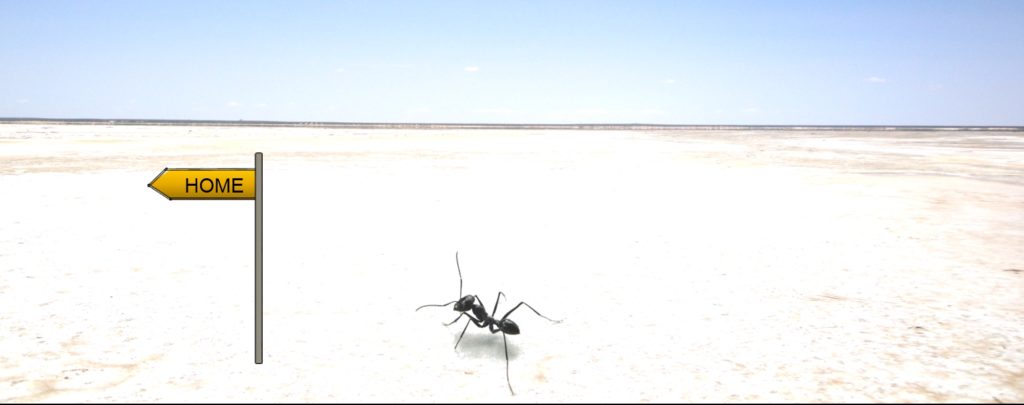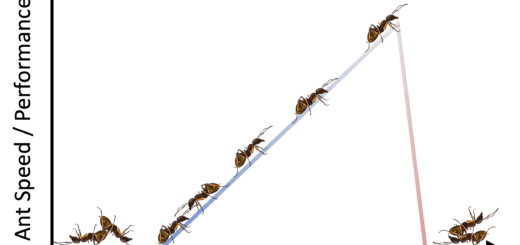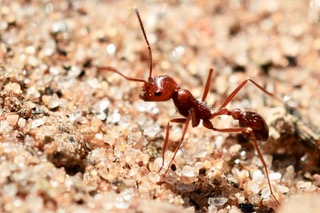Fascinating navigational skills in ants
In the recently published review paper “Neuroplasticity in desert ants (Hymenoptera: Formicidae) – importance for the ontogeny of navigation” in Myrmecological News, Wolfgang Rössler reviews the impressive behavioural and neuronal plasticity in the desert ant Cataglyphis at their transition from interior worker to forager. In this review, Cornelia Buehlmann highlights his main points.
A Review compiled by Cornelia Bühlmann

Fascinating navigational skills in ants
Navigation is a universal behaviour and of great importance for most animals including humans. In our everyday life, we constantly navigate through the world using learnt information essential to move along routes or to return to known places. Even though we often believe ourselves to have good spatial knowledge, we observe much more impressive navigational behaviours in the animal kingdom. For instance, homing pigeons find their way back to their home loft even from unfamiliar places, and some seabirds forage for food covering huge distances and always manage to return to their specific nesting site.
Other animals with remarkable spatial
In the last few decades, one particularly productive line of research has been from studies of navigation in the fascinating Cataglyphis desert ants (see Wehner 2009, Collett & al. 2013, Knaden & Graham 2016). On sunny summer days, Cataglyphis desert ants flit around on the scorching desert ground, and during such a foraging journey, an ant worker can reach a position hundreds of meters away from her nest from where she needs to be able to return home to her colony (Knaden & Graham 2016, and references therein). With a good directional sense driven by celestial mechanisms and a step counter to measure the distances covered, ants can implement an innate navigational mechanism called path integration, which is widespread among animals (reviewed in Ronacher 2008, Heinze & al. 2018). A continuous update of direction and distance informs ants where they are relative to their nest so that they can take the quickest route home when they have a food item or it becomes too hot (Figure 1).
In addition to path integration, ants learn and use visual information for navigation (reviewed in Zeil 2012, Wehner & al. 2014). Ant foragers need to memorise the visual surroundings and also calibrate their sensory system.

At the beginning of an ant’s foraging life
In this recently published review article, Wolfgang Rössler provides a nice overview of the behavioural transition at the start of an ants’ foraging activity that facilitates establishing and setting-up of their navigational toolkit (Rössler 2019). Before becoming expert foragers and navigators, ants stay underground in their dark nest for the first month of their lives doing household tasks (see Figure 2). When an ant emerges from the dark nest and experiences bright sunlight for the first time, her sensory input changes. At this point, she has to acquire the necessary knowledge to succeed as a forager. This involves learning about the nest location and the ephemeris function, which describes how the sun moves during the day for that place and moment in time. During this inside-out transition, ants spend 2-3 days performing short journeys around the nest entrance, walking multiple loops in different directions around the nest and repeatedly stopping, turning, and looking back to the nest. These well-choreographed learning routines, so-called learning walks, are crucial, and their general purpose is the acquisition of information about the visual surroundings of the nest with relation to celestial compass cues. Until recently, we didn’t know how ants control these nest fixations, but from recent experiments performed by Wolfgang Rössler and his co-workers, we have learnt that the earth’s magnetic field is used as a reference to align these nest-directed views in naïve ants (Rössler 2019). Studying ant behaviour in their natural environment allows researchers to closely investigate how the ants’ natural sensory ecology influences their behaviour. Learning walks across different ant species show many similarities, however, high-speed video recordings of learning walks from Cataglyphis species in various habitats have revealed that learning walks are adapted to their visual ecology (Rössler 2019). Rössler and other researchers from his lab have shown that ants from cluttered environments providing rich visual information perform multiple precise movements which result in fixations of the nest when the ant can store useful panoramic snapshots. Species from barren terrains, however, rarely show these fixations as part of their general learning, and for them, these learning walks are probably used to learn more about the ephemeris function.

From the behaviour to the brain
A neuroethological approach in insect navigation is to try and understand the neural architecture which allows small-brained animals to produce robust behaviour in complex natural worlds (for reviews, see also Webb & Wystrach 2016, Heinze 2017). In Rössler’s review, he focuses on two major visual pathways that transfer information needed for navigation to the sensory integration centres in the ant’s brain (Rössler 2019). The sky-compass pathway transfers celestial information collected by the UV-sensitive ommatidia of the compound eye to the brain area responsible for sensorimotor integration and coordinated movement (central complex). It seems to be highly conserved across insects reflecting a general need for insects to control their movement relative to external sensory information. The second, called the mushroom body pathway, projects visual information to the mushroom body calyces, a brain area responsible for learning. This pathway is thought to be associated with the central-place foraging behaviour seen in hymenopteran insects and is not conserved across insects reflecting the high volume of learning required for social insect foragers. At the ants’ drastic transition from being an interior worker to becoming an outdoor forager, which is when the learning walks are performed, the ants’ sensory systems and both sensory pathways undergo drastic changes.
Getting insights into neuroplasticity during early visual learning in these highly visually guided navigators moves us a big step
References
Collett, M., Chittka, L. & Collett, T. 2013: Spatial Memory in Insect Navigation. – Current Biology 23: R789-R800.
Heinze, S. 2017: Unraveling the neural basis of insect navigation. – Current Opinion in Insect Science 24: 58-67.
Heinze, S., Narendra, A. & Cheung, A. 2018: Principles of Insect Path Integration. – Current Biology 28: R1043-R1058.
Knaden, M. & Graham, P. 2016: The Sensory Ecology of Ant Navigation: From Natural Environments to Neural Mechanisms. In: Annual Review of Entomology, Vol 61 (ed. Berenbaum, MR), pp. 63-76.
Ronacher, B. 2008: Path integration as the basic navigation mechanism of the desert ant Cataglyphis fortis (FOREL, 1902) (Hymenoptera: Formicidae). – Myrmecological News 11: 53-62.
Rössler, W. 2019: Neuroplasticity in desert ants (Hymenoptera: Formicidae) – importance for the ontogeny of navigation. – Myrmecological News 29: 1-20.
von Frisch, K. 1967: The Dance Language and Orientation of the Bees. Cambridge, MA: Harvard University Press.
Webb, B. & Wystrach, A. 2016: Neural mechanisms of insect navigation. – Current Opinion in Insect Science 15: 27-39.
Wehner, R. 2009: The architecture of the desert ant’s navigational toolkit (Hymenoptera: Formicidae). – Myrmecological News 12: 85-96.
Wehner, R., Cheng, K. & Cruse, H. 2014: Visual Navigation Strategies in Insects: Lessons from Desert Ants. New Visual Neurosciences edn. MA: MIT Press, Cambridge.
Zeil, J. 2012: Visual homing: an insect perspective. – Current Opinion in Neurobiology 22: 285-293.
Featured image: Cataglyphis ants (© Robin Grob)





Recent Comments